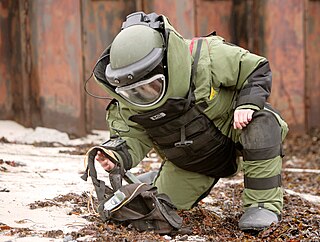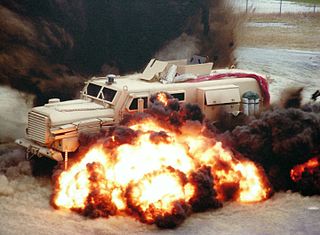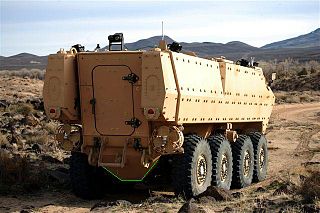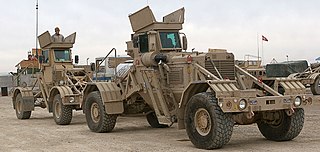
Bomb disposal is an explosives engineering profession using the process by which hazardous explosive devices are disabled or otherwise rendered safe. Bomb disposal is an all-encompassing term to describe the separate, but interrelated functions in the military fields of explosive ordnance disposal (EOD) and improvised explosive device disposal (IEDD), and the public safety roles of public safety bomb disposal (PSBD) and the bomb squad.

The Buffalo is a wheeled mine resistant ambush protected (MRAP) armored military vehicle built by Force Protection, Inc., a division of General Dynamics. It is the largest vehicle in Force Protection's line-up, followed by the Cougar MRAP and the Ocelot light protected patrol vehicle (LPPV).

The Cougar is a mine-resistant ambush-protected (MRAP) and infantry mobility vehicle structured to be resistant to landmines and improvised munitions.
Force Protection, Inc. was a manufacturer of ballistic- and blast-protected vehicles from the United States which have been used in Iraq, Afghanistan, Kosovo and other hot spots around the world. The company was acquired by General Dynamics in 2011.

The Snatch Land Rover is a protected patrol vehicle based on the Land Rover Defender 110 chassis. Intended for general patrolling in low-threat areas, the vehicle was developed in 1992 for use in Northern Ireland. It provides a limited degree of small arms protection for occupants and a limited level of protection from Improvised Explosive Devices and off-route mines.

A bomb suit, Explosive Ordnance Disposal (EOD) suit or a blast suit is a heavy suit of body armor designed to withstand the pressure generated by a bomb and any fragments the bomb may produce. It is usually worn by trained personnel attempting bomb disposal. In contrast to ballistic body armors, which usually focus on protecting the torso and head, a bomb suit must protect all parts of the body, since the dangers posed by a bomb's explosion affect the entire body.

An infantry mobility vehicle (IMV) is a wheeled armored personnel carrier (APC) serving as a military patrol, reconnaissance or security vehicle. Examples include the ATF Dingo, Iveco LMV, Oshkosh M-ATV, AMZ Dzik, AMZ Tur, Mungo ESK, and Bushmaster IMV. This term also applies to Mine-Resistant Ambush Protected (MRAP) vehicles.

Mine-Resistant Ambush Protected is a term for United States military light tactical vehicles produced as part of the MRAP program that are designed specifically to withstand improvised explosive device (IED) attacks and ambushes. The United States Department of Defense MRAP program began in 2007 as a response to the increased threat of IEDs during the Iraq War. From 2007 until 2012, the MRAP program deployed more than 12,000 vehicles in the Iraq War and War in Afghanistan.
Plasan is an Israeli-based company that now specializes in survivability solutions for all domains, the design, development and manufacture of protected vehicles, and most recently maneuvering robotics.

The Army Combat Shirt (ACS) is a flame-resistant shirt developed and used by the United States Army as a supplementary addition to the Army Combat Uniform (ACU). The ACS is a stand-alone shirt designed specifically for use with Improved Outer Tactical Vest (IOTV) in warm and hot weather instead of the blouse, and was introduced in 2007. It is intended to greatly increase user comfort through the use of lightweight, moisture-wicking, and breathable fabrics. The ACS was created in conjunction with the USMC's Flame Resistant Organizational Gear (FROG). The ACS, in conjunction with the Fire Resistant ACU (FRACU) trousers, provides head-to-toe protection against burns.

The Medium Mine Protected Vehicle (MMPV) is a class of armored vehicles being procured by the US Army, similar to the MRAP program, which is being pursued by the US Army and the US Marine Corps.

The V-hull is a type of vehicle armor design used on wheeled armored personnel carriers (APCs), infantry mobility vehicles, infantry fighting vehicles (IFVs) and MRAPs. The design originated in the 1970s with vehicles such as the iconic Casspir used extensively during the South African Border War, Leopard security vehicle used in the Rhodesian Bush War and South African armored vehicle company Land Systems OMCs and Buffels.
List of abbreviations, acronyms and initials related to military subjects such as modern armour, artillery, infantry, and weapons, along with their definitions.

The Husky VMMD is a configurable counter-IED MRAP vehicle, developed by South African-based DCD Protected Mobility and American C-IED company Critical Solutions International. Designed for use in route clearance and de-mining operations, the Husky is equipped with technologies to help detect explosives and minimise blast damage.

The Force Protection Ocelot is a British armoured vehicle that replaced the United Kingdom's Snatch Land Rover with British forces. It received the service name Foxhound, in line with the canine names given to other wheeled armored vehicles in current British use such as Mastiff, Wolfhound, and Ridgeback, which are all variants of the Cougar.

Iraqi Light Armored Vehicle or International Light Armored Vehicle is an armored fighting vehicle based on the Cougar and manufactured by Force Protection Industries, BAE Systems and General Dynamics.

Counter-IED equipment are created primarily for military and law enforcement. They are used for standoff detection of explosives and explosive precursor components and defeating the Improvised Explosive Devices (IEDs) devices themselves as part of a broader counter-terrorism, counter-insurgency, or law enforcement effort.
The Armor Survivability Kit (ASK) is an armor kit developed by the U.S. Army Research Laboratory (ARL) in 2003 to protect vehicles like the Humvee from small arms, explosive device fragments, and rocket-propelled grenades (RPGs).
U.S. Army Research Laboratory (ARL) research on MRAP Armor Weight Reduction Spiral (MAWRS) program resulted in armor technologies 40 percent lighter, with technologies fielded on more than 10,000 MRAP vehicles. Dozens of spin-out designs were provided to most major combat and tactical wheeled-vehicles program in production.
The Light Armoured Vehicle (LAV) is a series of armoured vehicles built by General Dynamics Land Systems – Canada (GDLS-C), a London, Ontario-based subsidiary of General Dynamics. It is a license-produced version of the Mowag Piranha. The first generation of LAV was created by Mowag for the Armoured Vehicle General Purpose (AVGP) requirement of the Canadian Army. This was a 6x6 variant of the Piranha I produced by General Motors Diesel in London, Ontario. Since entering service in 1976, it has undergone a number of upgrades. The LAV II introduced the now-familiar 8x8 configuration. The LAV continues to form the backbone of the Canadian Army's combat vehicle fleet. The LAV series of vehicles exist in a number of different variants and are used in a number of different roles such as armoured personnel carriers, engineering vehicles, command posts, ambulances and armoured recovery vehicles.














